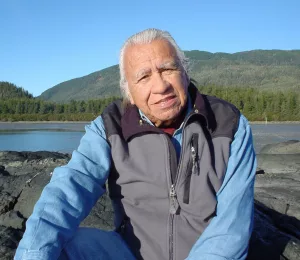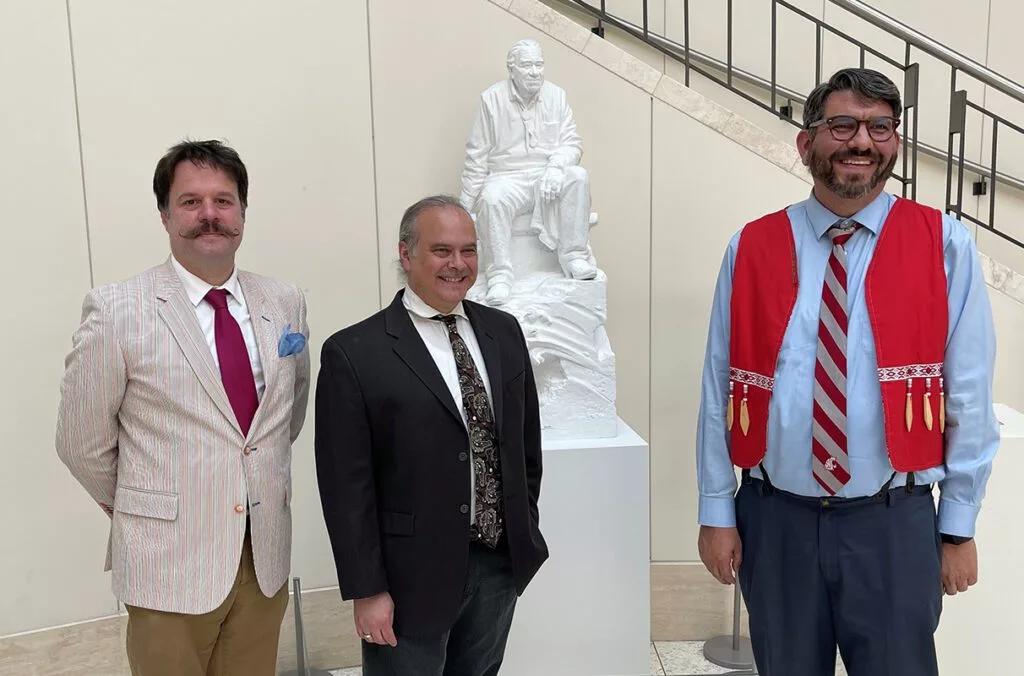PULLMAN, WA – A half-scale model—or maquette—of a statue of Nisqually activist Billy Frank Jr. is on display at Terrell Library through May 3, one stop of a statewide tour sponsored by ArtsWA and the Nisqually Indian Tribe. Washington State University’s Department of History, Jordan Schnitzer Museum of Art, and WSU Libraries arranged for the maquette’s appearance in Pullman.
Frank’s bronze statue will be part of the National Statuary Hall Collection, composed of statues donated by individual states to honor historically important figures. It will be installed this year in the U.S. Capitol in Washington, D.C., and another statue will be housed at the Washington State Capitol in Olympia.
To mark the occasion, three tribal leaders will discuss Native fishing rights and fishing advocacy at 3 p.m. Friday, April 18, in the Terrell Library atrium. The event is free and open to all. Panelists are:
- Jeremy “JJ” Wilbur, Swinomish Tribe member and a generational fisherman. He serves on the Swinomish Tribal Senate.
- Nakia Williamson-Cloud, director of cultural resources for the Nez Perce Tribe. He gained much of his knowledge and education concerning the traditional Nimiipuu (Nez Perce) way of life from culture bearers over a lifetime. Williamson-Cloud has worked in cultural resource management for more than 20 years.
- Jon Eli Sirois (pronounced Sigh Eye), citizen of the Confederated Tribes of the Colville Reservation and member of the respective Okanagan, Methow, and Wenatchi Tribes. He served over 20 years in the Colville Tribes’ government as an elected representative and in departments that focused on tribal lands, cultural preservation and revitalization, economic development, renewable energy project development, policy development, and governance.

“We’re honored to partner with the Nisqually Indian Tribe, the governor’s office, and colleagues around the state to share Billy’s urgent story,” said ArtsWA Executive Director Karen Hanan. “Over the last year, Billy has visited everywhere from Bainbridge Island to Omak. We’re thrilled that his message of perseverance, collaboration, and environmental stewardship will now come to Pullman and Washington State University.”
WSU Assistant Professor of History Ryan Booth drove to Olympia March 31 to pick up the maquette for its Pullman stop. Booth, an Upper Skagit Tribe member, met Frank once in the early 2000s at Swinomish for a “First Salmon Ceremony.” It was an unforgettable experience, partly because Frank mentioned people in Booth’s home community who fought for treaty rights.

“When the statue made it into the van that day, it felt almost like carrying an honored loved one. It wasn’t the feeling of a funeral. It was more like an honoring or celebration,” Booth said. “He had a power to bring people together. He never made that work about himself. He may have convened people, but he was never the center of attention. I think that’s the beauty of this.”
WSU Libraries Interim Dean Trevor Bond said he is pleased to have the statue in Terrell Library, the very heart of the Pullman campus.
“His presence and advocacy have contributed to numerous events this month, including President Betsy Cantwell’s welcome reception, the Sherman and Mabel Smith Pettyjohn Lecture on Native American History, and the opening of the Native American Advisory Board meeting,” Bond said.
Choosing a contemporary Washington hero
Rep. Debra Lekanoff introduced House Bill 1372 in early 2021 to replace the statue of pioneer missionary Marcus Whitman, erected in 1953 in National Statuary Hall, with “a more contemporary Washingtonian to further celebrate the state and the continuous contributions Washingtonians have made in the 20th and 21st centuries.”
According to the bill, “Billy Frank Jr. is a significant historical and civil rights figure who is worthy of recognition and inclusion” in the National Statuary Hall Collection. Gov. Jay Inslee signed the bill in April of the same year.
Western Washington-based Chinese American sculptor Haiying Wu was chosen to design the Frank statue. Consulting with the Nisqually Indian Tribe, the Frank family, and the selection committee, Wu created a concept that places the treaty-rights activist at the edge of the Nisqually River with salmon leaping at his feet. The pedestal is inscribed with Frank’s common statement, “Tell Your Story,” along with his name.
Early last year, Wu sculpted the maquette, followed by the full-size clay model over the summer. Next steps are approval of the full-scale model by the Architect of the Capitol, reviewing bids by local foundries and choosing the finalist, and casting the clay into bronze.
“We are truly honored to have this opportunity to recognize my father, Billy Frank Jr., as one of our great leaders here in the state of Washington,” said Willie Frank III. “It shows the progress and the growth of our state to honor Billy Frank Jr., who was arrested more than 50 times for fishing.”





